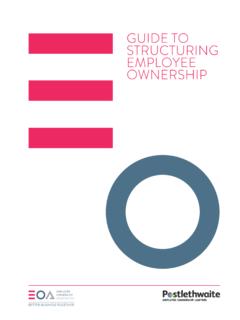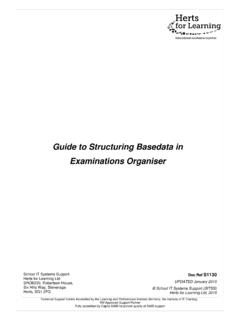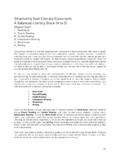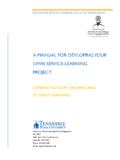Transcription of GSN COMMUNITY STANDARD VERSION 1 - Goal Structuring …
1 GSN COMMUNITY STANDARD VERSION 1 2011 Origin Consulting (York) Limited, on behalf of the Contributors i GSN COMMUNITY STANDARD VERSION 1 November 2011 GSN COMMUNITY STANDARD VERSION 1 2011 Origin Consulting (York) Limited, on behalf of the Contributors ii FOREWORD This STANDARD has two intended functions. Firstly, it seeks to provide a comprehensive, authoritative definition of the Goal Structuring Notation (GSN). Secondly, it aims to provide clear guidance on current best practice in the use of the notation for those concerned with the development and evaluation of engineering arguments argument owners, readers, authors and approvers. The STANDARD was developed by means of a consensus process involving GSN users from both academia and industry, between 2007 and 2011. The document history on page iii outlines the recent history of the collaboration, and a list of contributors to the STANDARD is provided on page iv.
2 GSN COMMUNITY STANDARD VERSION 1 2011 Origin Consulting (York) Limited, on behalf of the Contributors iii DOCUMENT HISTORY VERSION Issued to Date Purpose Draft Standardisation Committee 2nd May 2010 For review prior to general circulation Draft User COMMUNITY and interested parties 19th May 2010 For consultation and comment Draft Standardisation Committee 3rd September 2011 For review prior to issue Issue 1 User COMMUNITY 16th November 2911 For use GSN COMMUNITY STANDARD VERSION 1 2011 Origin Consulting (York) Limited, on behalf of the Contributors iv INDIVIDUAL CONTRIBUTORS Katrina Attwood Paul Chinneck Martyn Clarke George Cleland Mark Coates Trevor Cockram George Despotou Luke Emmet Jane Fenn Ben Gorry Ibrahim Habli Christopher Hall Andrew Harrison Richard Hawkins Pete Hutchison Andrew Jackson Tim Kelly Peter Littlejohns Paul Mayo Lisa Logan Ron Pierce Clive Pygott Graeme Scott Mick Warren Phil Williams CONTRIBUTING ORGANISATIONS AACE Ltd Adelard LLP Altran Praxis Ltd BAE Systems Ltd Columbus Computing Ltd CSE International Ltd ERA Technology Ltd General Dynamics UK Ltd LR Rail Ltd Origin Consulting (York) Ltd RPS Group Ltd SafeEng Ltd Selex-Galileo Ltd Thales Ltd UK Ministry of Defence University of York GSN COMMUNITY STANDARD VERSION 1 2011 Origin Consulting (York) Limited, on behalf of the Contributors v TABLE OF CONTENTS FOREWORD.
3 Ii DOCUMENT HISTORY .. iii INDIVIDUAL CONTRIBUTORS .. iv CONTRIBUTING ORGANISATIONS .. iv TABLE OF CONTENTS .. v INTRODUCTION TO THE STANDARD .. 1 Part 0: INTRODUCTION AND CONCEPTS .. 2 Introductory .. 2 Use of Arguments in Assurance Cases .. 2 What is an Argument? .. 2 The Goal Structuring Notation (GSN) .. 3 PART 1: DEFINITION OF THE GOAL Structuring NOTATION .. 7 Introductory .. 7 Notation .. 7 Notation Interpretation .. 9 The Language of Goal Structures .. 14 ANNEXES TO PART 1 .. 15 A1 EXTENSIONS TO GSN TO SUPPORT ARGUMENT PATTERNS .. 15 Introductory .. 15 Structural Abstraction in GSN .. 15 Entity Abstraction in GSN .. 16 B1 MODULAR EXTENSIONS TO GSN .. 17 Introductory .. 17 Notation Extensions .. 17 Notation Interpretation .. 20 Intra-Module Notation .. 20 Inter-Module Notation .. 22 Part 2: GUIDANCE ON THE DEVELOPMENT AND EVALUATION OF GOAL STRUCTURES .. 25 Introductory .. 25 GSN COMMUNITY STANDARD VERSION 1 2011 Origin Consulting (York) Limited, on behalf of the Contributors vi Guidance on the Layout of Goal Structures.
4 26 Developing Goal Structures Top-Down: The GSN Six-Step Method .. 27 Overview .. 27 Step 1: Identify Goals .. 28 Step 2: Definition of the Basis on which Goals are Stated .. 28 Step 3: Identification of Strategy .. 30 Step 4: Definition of the Basis on which the Strategy is Stated .. 32 Step 5: Elaborate Strategy .. 33 Step 6: Identify Solutions .. 35 What if we can t close out the argument? .. 36 Developing Goal Structures Bottom-Up: Working from Available Evidence .. 37 Introductory .. 37 Bottom-Up Step 1: Identify Relevant Evidence .. 39 Bottom-Up Step 2: Infer Evidence Assertion Goals .. 39 Bottom-Up Step 3: Adding Higher Sub-Goals .. 41 Bottom-Up Step 4: Describe Strategy for Goal-Decomposition .. 42 Bottom-Up Step 5: Adding Contextual Information .. 43 Bottom-Up Step 6: Check Back Down the Goal Structure .. 44 Bottom-Up Step 7: Incorporate Bottom-Up Goal Structure into Higher (Top-Down) Argument .. 44 What if I Can t Convince Myself?.
5 45 Avoidance of Common Errors in Creating Goal Structures: Part 1 Language Issues .. 46 Introductory .. 46 Language used in GSN Elements .. 46 The Essay in the Box .. 47 Ambiguity .. 48 Vagueness .. 48 Oversimplification .. 49 Avoidance of Common Errors in Creating Goal Structures: Part 2 Structural Issues .. 49 Jumping Ahead .. 49 Erroneous Use of Context .. 50 Erroneous Use of Strategies .. 50 GSN COMMUNITY STANDARD VERSION 1 2011 Origin Consulting (York) Limited, on behalf of the Contributors vii Leaps of Faith .. 51 Evaluating Goal Structures: A Step-by-Step Approach .. 53 Introductory .. 53 The Role of Review in the Lifecycle .. 53 Problems Commonly Experienced in Reviews .. 54 A Staged Argument Review Process .. 54 ANNEXES TO PART 2 .. 60 A2 GUIDANCE ON PATTERN EXTENSIONS .. 60 B2 GUIDANCE ON MODULAR EXTENSIONS .. 60 C2 OTHER EXTENSIONS TO GSN .. 61 Introductory .. 61 GLOSSARY .. 63 REFERENCES .. 64 GSN COMMUNITY STANDARD VERSION 1 2011 Origin Consulting (York) Limited, on behalf of the Contributors 1 INTRODUCTION TO THE STANDARD The purpose of this STANDARD is to define the Goal Structuring Notation (GSN) and to provide guidance on its usage.
6 GSN is a graphical argumentation notation that can be used to document explicitly the individual elements of any argument (claims, evidence and contextual information) and, perhaps more significantly, the relationships that exist between these elements ( how claims are supported by other claims, and ultimately by evidence, and the context that is defined for the argument). Arguments documented using GSN can help provide assurance of critical properties of systems, services and organisations (such as safety or security properties). The STANDARD has four parts, as follows: Part 0: Introduction and Concepts (informative). This part provides an overview of the concepts of GSN and its role in communicating arguments. It can be used as a standalone introduction to GSN and how the notation relates to basic principles of argumentation. Part 1: Definition of GSN (normative). This part is divided into two sections. The first section provides a normative definition of the syntax of GSN, including its visual syntax.
7 In the second section, which is intended to be more informative, the semantics of the notation is provided, clarifying the meanings of STANDARD GSN structures. Annexes to Part 1 define the syntax and semantics of extensions that have been made to GSN, for example those made to enable GSN to describe generic argument patterns and modular argument structures. Part 2: Guidance on the Use of GSN (informative). This part provides informative guidance on the effective use of GSN to create and evaluate structured arguments. Part 3: Web-Based Resources (still in development). This part provides additional informative guidance on the use of GSN, including further examples of goal structures and catalogues of existing argument patterns. These resources are currently under development, and will be made available in due course. GSN COMMUNITY STANDARD VERSION 1 2011 Origin Consulting (York) Limited, on behalf of the Contributors 2 Part 0: INTRODUCTION AND CONCEPTS Introductory This part of the STANDARD provides sufficient information about GSN to enable a novice user to read and understand a goal structure represented using the notation without recourse to the remainder of the STANDARD .
8 Arguments presented using GSN can help provide assurance of critical properties of systems, services or organisations (such as safety or security properties). Such arguments can form a key part of an overall assurance case. The role of arguments in assurance cases is explained in Section Use of Arguments in Assurance Cases The concept of assurance cases has long been established in the assurance domain where for many industries the development, review and acceptance of an assurance case forms a key element of safety assurance processes. An assurance case can be defined as: A reasoned and compelling argument, supported by a body of evidence, that a system, service or organisation will operate as intended for a defined application in a defined environment. In practice, an assurance case will have a particular focus. For example, a safety case will demonstrate that a given system is acceptably safe in a given context. In order that assurance cases can be developed, discussed, challenged, presented and reviewed amongst stakeholders, and maintained throughout the product lifecycle, it is necessary for them to be documented clearly.
9 The documented argument of the assurance case should be structured to be comprehensible to all safety-case stakeholders. It should also be clear how the evidence is being asserted to support this argument. By appealing to core concepts of argumentation, GSN helps address these objectives. What is an Argument? In the sense used in assurance cases, an argument is defined as a connected series of claims intended to establish an overall claim. In attempting to persuade others of the truth of an overall claim, we make supporting claims. These claims may themselves need further support. This gives rise to a hierarchy of claims (representing a logical chain of reasoning) by which an argument is established. At GSN COMMUNITY STANDARD VERSION 1 2011 Origin Consulting (York) Limited, on behalf of the Contributors 3 the heart of GSN is the explicit documentation of this hierarchy of claims. The key elements of the notation are explained in Section The Goal Structuring Notation (GSN) GSN is a graphical argument notation which can be used to document explicitly the elements and structure of an argument and the argument s relationship to evidence.
10 In GSN, the claims of the argument are documented as goals and items of evidence are documented in solutions. GSN element names are italicised throughout this STANDARD , to distinguish reserved uses of those words from ordinary usage. The relationships represented in GSN are: The predicate-conclusion relationship between goals and sub-goals; The support that solutions provide for claims; and The relationship between the argument and the context in which it is stated. The purpose of GSN is to document how claims (represented in GSN as goals) are said to be supported by sub-claims (also represented in GSN as goals). Figure 1 shows an example goal in GSN: Goal_G1 System X can tolerate single component failures Figure 1: An Example Goal Where evidence is asserted to support the truth of the claim, this can be documented by providing a solution in GSN. Figure 2 shows an example solution (reference to evidence) in GSN: Solution_Sn1 Fault Tree for Hazard H1 Figure 2: An Example Solution When documenting how claims are said to be supported by sub-claims, it can be useful to document the reasoning step the nature of the argument that connects the claim to its sub-claims.





